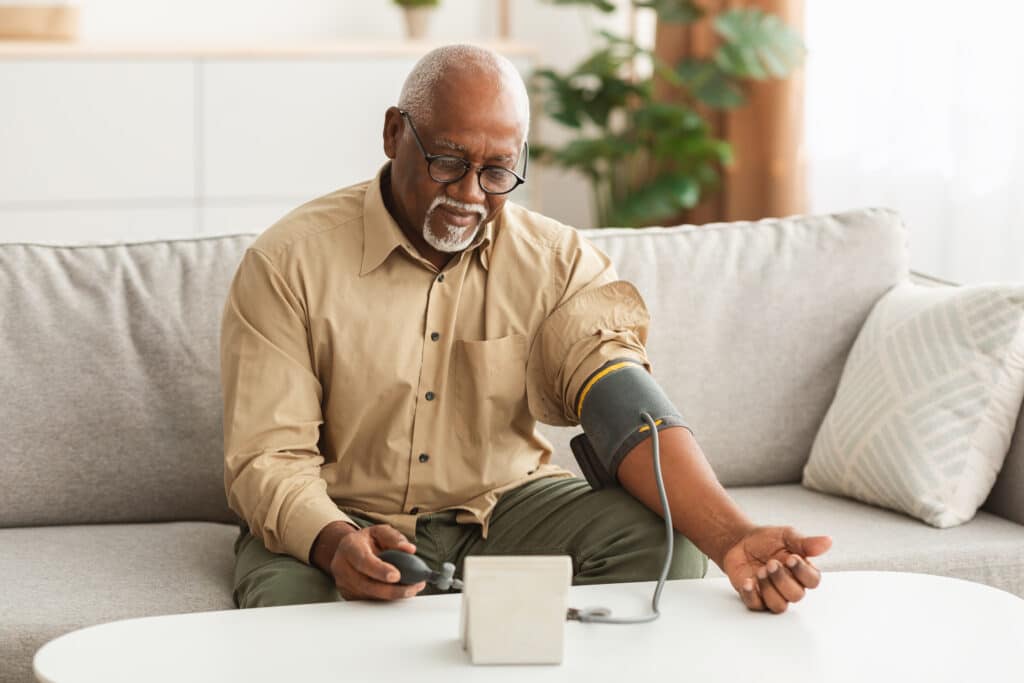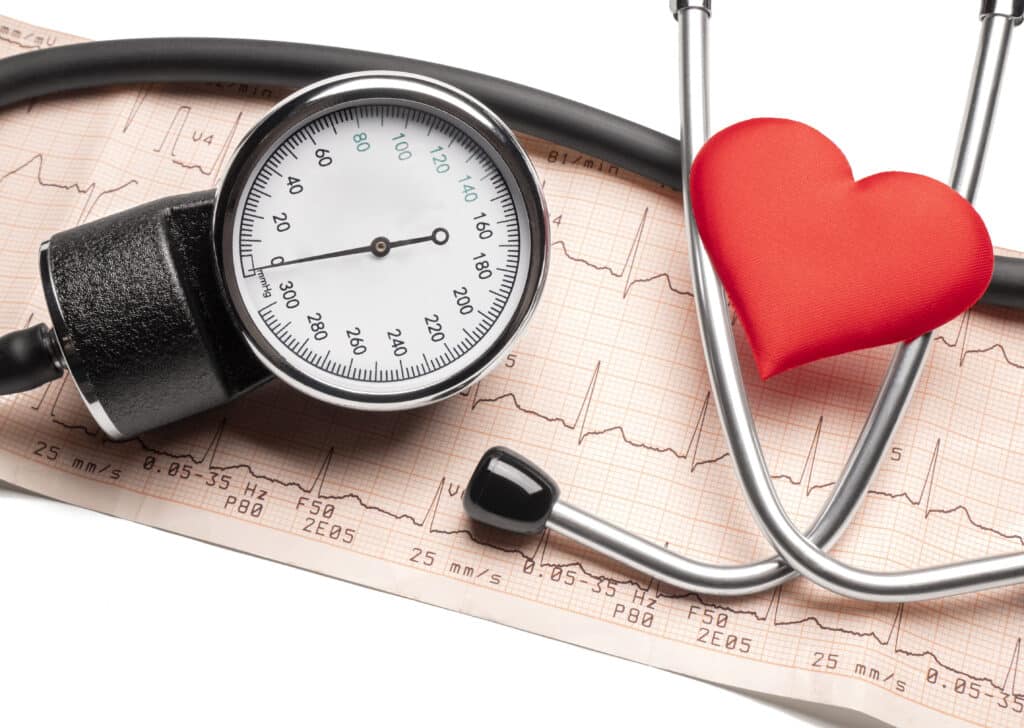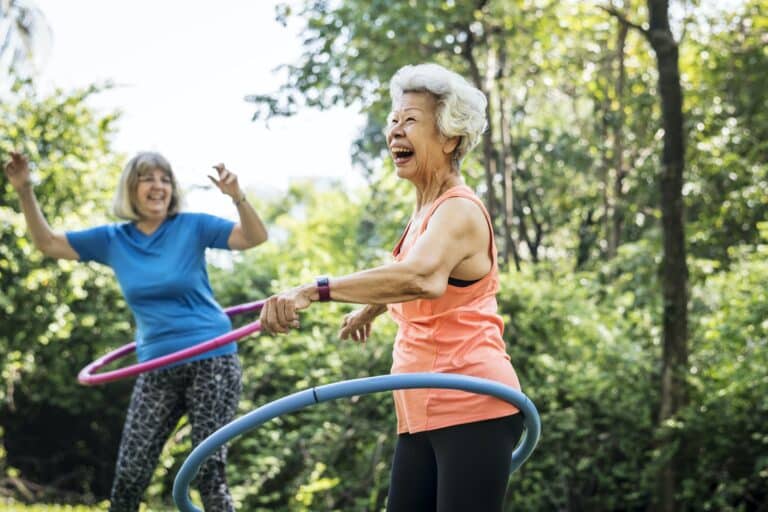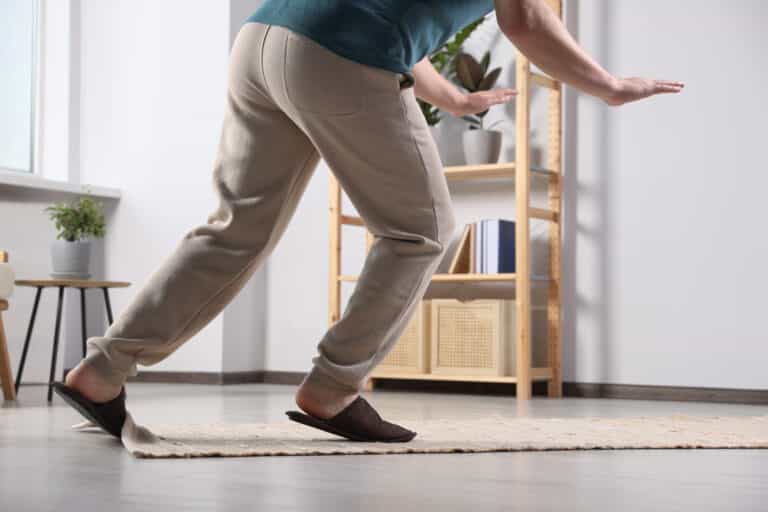Maintaining healthy blood pressure is crucial to our well-being, especially as we age. High blood pressure—or hypertension—is a common concern for many active adults. Despite being a common issue, it’s important not to underestimate its dangers.
Untreated high blood pressure can lead to serious health complications, including heart disease, stroke, and kidney problems.
The good news? Exercise can help you manage your blood pressure!
- A Primer on Blood Pressure Measurements
- Can I Work Out with High Blood Pressure?
- The Effects of Regular Exercise on Blood Pressure
- How Exercise Influences Blood Pressure Regulation
- When Is It Safe (or Unsafe) to Exercise with High Blood Pressure?
- The Best Exercises for Lowering Blood Pressure
- An Introduction to How to Exercise Safely
- Key Takeaways
- FAQs
Over time, our blood vessels tend to become less flexible, and the risk of developing high blood pressure increases. This condition is often called “the silent killer” because it typically exhibits no noticeable symptoms in its early stages.
Alongside regular exercise, active adults should monitor their blood pressure regularly and work with healthcare professionals to manage and control it. Other lifestyle modifications like maintaining a healthy diet and taking medication (if necessary) are also effective interventions.
If you’ve ever wondered about the effects of exercise on your blood pressure or what exercises are safe to do with high blood pressure, you’re in the right place. Let’s explore exercise’s effect on blood pressure to keep you ahead of hypertension.
A Primer on Blood Pressure Measurements

Blood pressure is typically recorded as two numbers, written as a 120/80 mm Hg ratio. The first number (120 in this example) is the systolic pressure, and the second (80) is the diastolic pressure. When measuring blood pressure, mm Hg is simply the standard measurement for pressure. This reading is typically taken with a blood pressure cuff called a sphygmomanometer.
Systolic Pressure
The systolic pressure is the higher of the two numbers. It represents the pressure in your arteries when your heart beats and pumps blood out. This is the blood pressure against artery walls at the moment the heart pumps, reflecting the force generated by the heart as it contracts.
A normal systolic pressure is typically below 120 mm Hg. Higher values, especially those over 130 mm Hg, may indicate hypertension or high blood pressure.
Diastolic Pressure
The diastolic pressure is the lower number and indicates the pressure in your arteries when your heart rests between beats. This is the time when the heart fills with blood and gets oxygen. A normal diastolic pressure is lower than 80 mm Hg. Elevated diastolic readings, particularly those above 90 mm Hg, can signal hypertension.
Interpreting the Numbers
- Normal Blood Pressure: Systolic less than 120 and Diastolic less than 80 (120/80 mm Hg).
- Elevated Blood Pressure: Systolic is between 120-129, and Diastolic is less than 80.
- High Blood Pressure (Hypertension) Stage 1: Systolic between 130-139 or Diastolic between 80-89.
- High Blood Pressure (Hypertension) Stage 2: Systolic 140 or higher or Diastolic 90 or higher.
- Hypertensive Crisis: Systolic over 180 and/or Diastolic over 120.
Importance of Regular Monitoring
Regular blood pressure monitoring is crucial, especially for those with a history of hypertension, heart disease, or other related health issues. Consistent readings in the higher ranges warrant a consultation with a healthcare professional.
Can I Work Out with High Blood Pressure?
Now, let’s address a common concern I hear among many of my patients with hypertension: “Can I work out if I have high blood pressure?”
The short answer is yes, but there are some caveats, and it’s essential to do so safely and under the guidance of a healthcare professional.
Before we move on, I’d like to note that exercise is generally not recommended when your systolic pressure exceeds 200, or your diastolic pressure exceeds 100. Consult with your healthcare provider before starting or making significant changes to your exercise routine if you have hypertension.
Blood Pressure During and Immediately After Exercise
It’s no secret that exercise can lead to a surge in your heart rate and, subsequently, your blood pressure. But don’t let this discourage you. This immediate increase in blood pressure is a sign that your body is responding positively to the physical demands of your workout.
During exercise, your blood pressure can rise significantly. For example, your systolic blood pressure (the higher number) may increase by up to 20 mmHg or even more. This may sound concerning, but it’s essential to understand that this is a healthy response to physical exertion.
Elevated blood pressure is, thankfully, usually temporary. Your body redirects blood flow to provide your muscles with the oxygen and nutrients they need during the workout. When the activity is over, your blood pressure should return to normal.
So, while it’s common to experience a spike in blood pressure while exercising, it’s also crucial to monitor how it behaves post-workout.
The significance of monitoring your blood pressure during and after exercise lies in understanding how your body reacts to different activities. It can help you identify the right level of intensity for your fitness routine and ensure your workouts are effective and safe.
Safety Considerations and Precautions
It’s a good idea to be aware of certain safety considerations for high blood pressure.
It is imperative to start slowly, perform warm-up/cool-down exercises, and gradually increase the intensity of your workouts to allow your body to adapt appropriately.
Taking consistent, deep breaths while exercising is also critical. If you hold your breath while you exercise, especially while exerting yourself, you may cause a sudden, sharp increase in your blood pressure, which can be dangerous. This practice is common for people who lift heavy weights, but it is not recommended for people with hypertension.
If you’re unsure where to start, your physical therapist can help you determine the right exercise intensity and duration level that suits your condition.
Usually, I work closely with my patients during their first few exercise sessions to ensure their blood pressure remains within a safe range. Monitor your blood pressure regularly and inform your healthcare provider about any changes or concerns.
Start Slowly, Listen to Your Body
In many cases, exercise is safe and highly beneficial for individuals with high blood pressure. Low-to-moderate intensity exercises like walking, swimming, or cycling can be excellent choices. Always warm up before exercising and cool down afterward to prevent sudden spikes or drops in blood pressure.
There are situations when exercising with high blood pressure might not be advisable. If your blood pressure is severely uncontrolled or you have other underlying health issues, your healthcare provider may recommend avoiding strenuous activities.
As previously noted, heavy lifting and straining activities should be cautiously approached, as they can cause quick spikes in blood pressure. Even if your blood pressure is slightly above average, it’s important to keep this in mind.
The Effects of Regular Exercise on Blood Pressure

Regular exercise can play a significant role in improving and maintaining healthy blood pressure levels. Numerous studies have shown that individuals who engage in consistent physical activity experience lower blood pressure in the long run.
A study published in the Journal of the American Heart Association found that those who adhered to a consistent exercise routine had a 13% lower risk of developing high blood pressure than those who didn’t.1
So, can exercise help manage high blood pressure? The answer is a resounding yes.
Incorporating exercise into your lifestyle can be a practical part of managing high blood pressure. I start the visit with each physical therapy session by taking my patient’s blood pressure. In my professional experience, I consistently see the steadiest decline in blood pressure in patients who exercise regularly.
Regular physical activity promotes several positive changes in the body, such as improved blood vessel function, reduced arterial stiffness, and enhanced heart function. These factors contribute to maintaining healthy blood pressure over time.
How Exercise Influences Blood Pressure Regulation
Exercise triggers several physiological responses, ultimately contributing to better blood pressure regulation.
When you engage in physical activity, your heart beats faster, increasing the blood flow to your muscles. This, in turn, reduces the force on your arteries, leading to a drop in blood pressure.
Individuals who engage in regular aerobic exercise experience an average decrease of 3.84 mm Hg in systolic blood pressure and 2.58 mm Hg in diastolic blood pressure.2
Here are the key components leading to such improvements:
- Reduced Arterial Stiffness: As we age, our arteries can become less flexible, leading to higher blood pressure. Exercise helps maintain or improve the flexibility of your arteries. The more flexible the vessel, the more smoothly the blood flows.
- Enhanced Heart Function: Your heart is a powerful muscle, and it’s responsible for pumping blood throughout your body. Regularly exercising makes your heart more efficient at doing its job. You are essentially training your heart to work smarter, not harder, which can help lower blood pressure.
- Stress Reduction: Exercise can also help reduce stress, indirectly benefiting blood pressure. When stressed, your body produces hormones that can temporarily raise blood pressure. Yoga, deep breathing, or similar exercises can help you relax and manage stress.
Exercise is also known to aid in weight management, another crucial factor in controlling blood pressure.
In simple terms, exercise improves the function of your blood vessels and heart, making it easier for your body to manage blood pressure.
When Is It Safe (or Unsafe) to Exercise with High Blood Pressure?
The relationship between exercise and high blood pressure is multifaceted, and it’s essential to understand both the benefits and potential risks.
While exercise is generally beneficial, it may not be advisable in some situations. If your blood pressure is severely uncontrolled, or if you have other underlying health issues, intense exercise might lead to adverse effects. Vigorous activities involving heavy lifting, straining, or breath-holding should be cautiously approached. These can cause sudden, dramatic spikes in blood pressure.
In some cases, certain medications used to manage high blood pressure can affect your exercise capacity, so it’s important to discuss this with your healthcare provider.
When exercising with high blood pressure, one size doesn’t fit all. Your health condition, age, and fitness level are all crucial factors.
An individualized exercise plan, ideally developed in consultation with your healthcare provider or a qualified fitness expert, can help you reap the benefits of exercise while minimizing potential risks.
The key takeaway is that exercise can be a valuable tool for managing high blood pressure. Still, it must be approached carefully, especially if you have certain health concerns. Always consult your healthcare provider before starting or significantly changing your exercise routine.
The Best Exercises for Lowering Blood Pressure

In brief, a well-rounded exercise routine includes three primary components: aerobic, strength training, and flexibility exercises.
Aerobic Exercise
Aerobic (or cardiovascular) exercises are fantastic for heart health and controlling blood pressure. Here are some of my favorite options to recommend to patients:
- Brisk Walking: This low-impact activity is accessible to almost everyone. Start with 30 minutes a day, five days a week.
- Cycling: On a stationary bike or the open road, cycling is excellent for your heart and helps lower blood pressure.
- Swimming: It’s gentle on the joints and provides an excellent full-body workout.
Strength Training
Strength training exercises focus on building muscle mass and can reduce blood pressure by improving metabolism.
Examples include:
- Bodyweight Exercises: Push-ups, squats, lunges, and planks can be done at home without equipment.
- Weight Lifting: This includes using dumbbells, resistance bands, or machines at the gym. Extra resistance can add increased load, which challenges your muscles to work harder and get stronger.
Note: While weight lifting is generally healthy, starting with lighter weights and progressing slowly is usually a good idea when managing blood pressure, especially hypertension.
Flexibility
Flexibility exercises help reduce stress and promote relaxation, indirectly supporting healthy blood pressure.
Try these:
- Yoga: A practice that combines physical postures, breathing exercises, and meditation to improve flexibility and reduce stress.
- Stretching: Gentle stretching exercises can be performed daily to enhance flexibility and relaxation.
Remember to customize your routine based on your fitness level and preferences. It’s also crucial to monitor your blood pressure and adapt your exercises accordingly.
The key is consistency. Regular, sustained exercise is more likely to yield significant and lasting reductions in blood pressure. Finding an exercise routine you enjoy and can maintain long-term is also essential.
An Introduction to How to Exercise Safely
To ensure your exercise routine is both practical and safe, following some fundamental guidelines is crucial, especially when your focus is managing your blood pressure.
Warm Up and Cool Down Appropriately
Before diving into your workout, warm up with gentle exercises like walking or light stretching. This gradually raises your heart rate and prepares your muscles for more intense activity.
After your workout, don’t skip the cool-down. This phase involves slowing down your exercise intensity and performing gentle stretches to prevent sudden drops in blood pressure.
Progress Gradually
Whether you’re a beginner or an experienced exerciser, gradual progression is vital. I can’t stress this to my patients enough. Increasing the intensity or duration of your workouts too quickly can lead to spikes in blood pressure.
Start with a comfortable level of exercise and make minor, incremental adjustments as your fitness improves.
Pay Attention to Your Form
Using proper form makes your workout more effective and reduces the risk of injury. Breathing techniques are also essential. During strength training, for example, remember to exhale during the exertion phase and inhale during the relaxation phase. This can help maintain stable blood pressure.
Stay Hydrated
Dehydration can affect blood pressure, so stay hydrated throughout your workout. Sip water before, during, and after your exercise session.
Following these guidelines can significantly reduce the risk of sudden blood pressure spikes and ensure that your workouts remain safe and effective.
Key Takeaways
- Understanding systolic and diastolic blood pressure measurements is crucial for managing overall health, especially in older adults.
- Regular monitoring of blood pressure is essential, particularly for individuals with a history of hypertension or heart disease, to detect potential health risks early.
- It’s possible to exercise safely with high blood pressure under healthcare professionals’ guidance, but specific precautions are necessary when blood pressure levels are extremely high.
- A temporary elevation in blood pressure during exercise is a normal response, and monitoring blood pressure post-workout is crucial to understanding your body’s reaction.
- Consistent physical activity can lead to long-term benefits such as lower blood pressure levels and improved heart health.
- A well-rounded exercise routine that includes aerobic, strength training, and flexibility exercises significantly manages and lowers blood pressure.
- Safe exercise routines, including warm-up, cool-down, gradual progression, proper form, and staying hydrated, are vital for maintaining healthy blood pressure levels.
- Tailoring exercise routines to fit individual health conditions and fitness levels is essential for maximizing the benefits of physical activity while minimizing risks.
FAQs
Can blood pressure fluctuate significantly during different types of exercises?
Blood pressure can fluctuate during exercise, depending on the type and intensity. Aerobic activities like brisk walking or cycling typically cause moderate increases in blood pressure, while strength training can lead to more significant spikes.
It’s essential to monitor these changes and consult a healthcare provider to understand what’s normal for your condition.
How soon after exercising should I check my blood pressure to understand the impact?
It’s advisable to check your blood pressure within 30 minutes after exercising. This allows you to assess how your body responds to physical activity.
However, if you experience any discomfort or symptoms of high blood pressure during exercise, you should immediately stop and check your blood pressure.
Are there specific exercises to avoid if I have high blood pressure?
If you have high blood pressure, avoiding high-intensity exercises and activities involving heavy lifting or significant straining is generally recommended.
These activities can cause sudden spikes in blood pressure. Instead, opt for low-to-moderate intensity exercises like walking, swimming, or cycling, and always consult with your healthcare provider before starting a new exercise regimen.
Can regular exercise eliminate the need for blood pressure medication?
While regular exercise can significantly improve blood pressure and overall heart health, it may not permanently eliminate the need for medication.
The impact of activity on your need for medication depends on various factors, including the severity of your hypertension and overall health condition. Always discuss any changes in medication with your healthcare provider.
References
- Reboussin, D. M., Allen, N. B., Griswold, M. E., Guallar, E., Hong, Y., Lackland, D. T., … & Vupputuri, S. (2018). Systematic review for the 2017 ACC/AHA/AAPA/ABC/ACPM/AGS/APhA/ASH/ASPC/NMA/PCNA guideline for the prevention, detection, evaluation, and management of high blood pressure in adults: a report of the American College of Cardiology/American Heart Association Task Force on Clinical Practice Guidelines. Hypertension, 71(6), e116-e135.
- Whelton, S. P., Chin, A., Xin, X., & He, J. (2002). Effect of aerobic exercise on blood pressure: a meta-analysis of randomized, controlled trials. Annals of Internal Medicine, 136(7), 493–503. https://doi.org/10.7326/0003-4819-136-7-200204020-00006
- Carpio-Rivera, E., Moncada-Jiménez, J., Salazar-Rojas, W., & Solera-Herrera, A. (2016). Acute effects of exercise on blood pressure: a meta-analytic investigation. Arquivos brasileiros de cardiologia, 106, 422-433.






